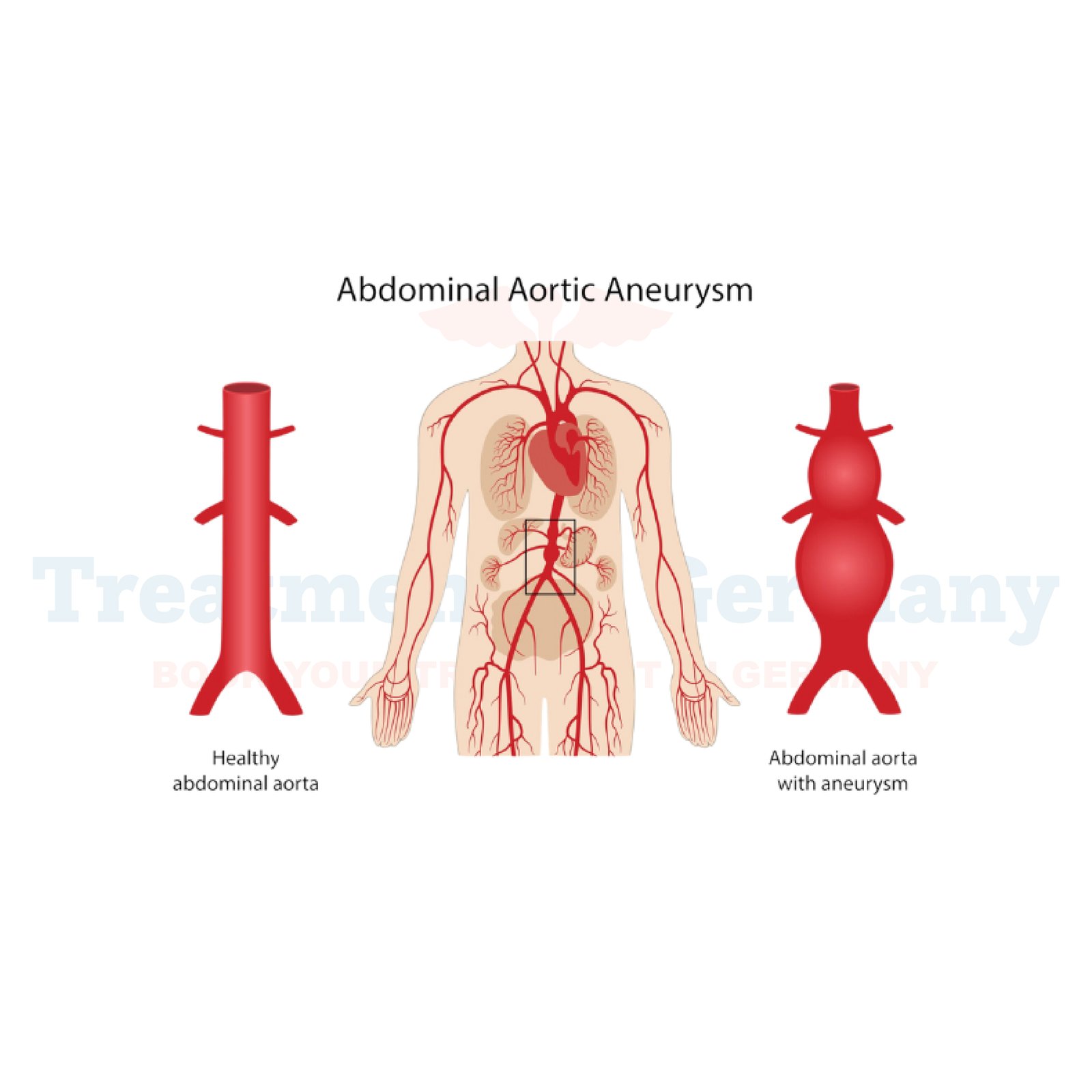Abdominal Aortic Aneurysm is a severe condition where the aorta the largest of all vessels that supply blood rich in oxygen from the heart to the lower abdomen, the pelvis, and both lower limbs swells or becomes enlarged. An aneurysm may cause massive hemorrhage and hypotension and finish with death if not treated appropriately.
Germany is one of the most specialized countries in healthcare services with state-of-the-art technology and a strong emphasis on developing new technology in the diagnosis and treatment of Abdominal Aortic Aneurysm (AAA).
A localized expansion of the abdominal aorta to a diameter greater than 1.5 times the predicted normal size is known as an abdominal aortic aneurysm.
The weakening can be due to hereditary, environmental, or lifestyle predispositions. Although some aneurysms are not likely to grow larger, larger ones are almost certain to rupture and lead to things like shortness of breath, syncope, and even cardiovascular disaster.
Risk Factors for Abdominal Aortic Aneurysm (AAA)
The following variables raise the risk of acquiring a Abdominal Aortic Aneurysm (AAA):
Such patients are older, male, or AFAB patients with a family history of Abdominal Aortic Aneurysm (AAA).
Symptoms of Abdominal Aortic Aneurysm (AAA)
Usually, most AAAs do not cause any signs until the size increases or becomes ruptured. Early symptoms may include:
Rupture symptoms are mild at first, but they become severe and include situations such as fainting, sudden abdominal pain, and low blood pressure that could be lethal.
Diagnosis of Abdominal Aortic Aneurysm (AAA) in Germany
German hospitals and clinics utilize advanced diagnostic methods to detect As accurately as:
Importance of Screening
Germany pays a lot of attention to these screenings rather early, especially to the specific population groups like those over 65 years, smokers, or those with a history of first-degree relatives’ Abdominal Aortic Aneurysm (AAA). Screening is particularly crucial as it allows early enough detection, thus preventing rupture of the aneurysm. Asymptomatic aneurysms of diameter up to 5 cm should be observed predictively at least once every 6 months.
Anterior and posterior AAA management in Germany
For small, asymptomatic aneurysms, the advised action plan is simply along with some modifications of the lifestyle. Patients are advised to:
Traditionally, endovascular repair of abdominal aneurysms is performed when the aneurysm size is greater than 5.5 cm or when the patient experiences symptoms. Germany offers two primary surgical options:
Conventional Surgical: Technique for the Treatment of Open Aneurysms
This is done by joining an artificial graft directly to both ends of the faulty area of the aorta and then cutting out the faulty part. However effective, this surgery necessitates a longer hospital duration and recovery interval because of the invasiveness.
Endovascular Aneurysm: Repair is another abbreviation, which means EVAR.
Like other forms of ‘vascular surgery’, EVAR is a non-invasive method of repair where a stent graft is put into the aorta through small incisions made in the groin. It helps strengthen the artery walls in order to prevent blood vessels from bursting or rupturing.
Why does Germany excel in Abdominal Aortic Aneurysm (AAA) treatment?
Germany’s vascular surgeons also aim at handling not only typical AAA but also cases with other forms of cells, genetic disorders, or AAA expansion to other arteries.
Technologies and methods in the field of the discipline
As a part of their treatment plan, German hospitals use robotics, diagnostic imaging, and personalized stent grafts. These innovations make precise procedures such as endovascular aneurysm repair (EVAR) to yield better patient results and minimize complications.
Comprehensive, Multidisciplinary Care
Many health-care organizations in Germany are integrating a team approach that operates closely with cardiologists, radiologists, and vascular surgeons. This means that patients receive healthy care and treatment that meet their generalized cardiovascular diseases.
Finally, there is the possibility of undertaking post-treatment monitoring and prevention of patient relapses.
Follow-Up Care After Surgery
It used patients who had recently been operated on for AAA in Germany and who were in proximity of medical centers for follow-up due to graft failure or endoleak. Standard wellness imaging checks such as abdominal duplex ultrasound and CTA are planned to evaluate the longevity of the repair.
The Abdominal Aortic Aneurysm (AAA) Management in Germany's Prospects for the Future
Germany remains one of the most progressive countries as far as the treatment of AAA is concerned. Current investigations look at how aneurysm progress can be slowed down without surgery and how to improve the long-term consequences of stent grafting. Further, efforts have begun to isolate images of cells or inflammatory mediators related to the aneurysm stage.
Frequently Asked Questions
Why is Germany one of the best places to have Abdominal Aortic Aneurysm (AAA) treated in the world?
Professionally competent diagnostic methods are proposed by German-speaking experts, such as the latest invasive service; new avenues, for example, in establishing EVAR and the highest MD Team care will result in optimum patient outcomes.
What role does screening play within the management of Abdominal Aortic Aneurysm (AAA)?
It was found that regular screenings for all patients are also important to identify those with AAA that have not yet ruptured.
What is the prevalence of open and endovascular repair of Abdominal Aortic Aneurysm (AAA) in Germany?
EVAR is a less invasive form of treatment. However, open aneurysm repair is also an option available to patients depending on their condition.
To what extent can lifestyle modifications be beneficial following treatment of Abdominal Aortic Aneurysm (AAA)?
Hypertension, coronary heart disease, smoking cessation, and following a heart-healthy diet help avoid other impairments to the cardiovascular system.
What are the recommended treatments and procedures after Abdominal Aortic Aneurysm (AAA) surgery?
Patients require repeated imaging studies, including abdominal duplex ultrasound and CTA, to evaluate the result of the repair process and exclude possible complications like endoleak.
👉 Contact us for further information and receive a complimentary consultation.

.webp)
.webp)
 (1).webp)
 (1).webp)

.webp)
.webp)
 (1).webp)
 (1).webp)
